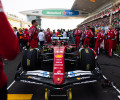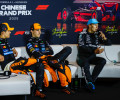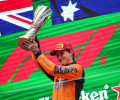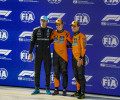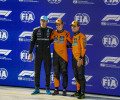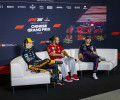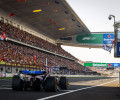Grand Prix d'Autriche 2019 - Conférence de presse du vendredi (en anglais)
TEAM REPRESENTATIVES – Mario ISOLA (Pirelli), Andrew GREEN (Racing Point), Paul MONAGHAN (Red Bull Racing), Toyoharu TANABE (Honda), Andreas SEIDL (McLaren)
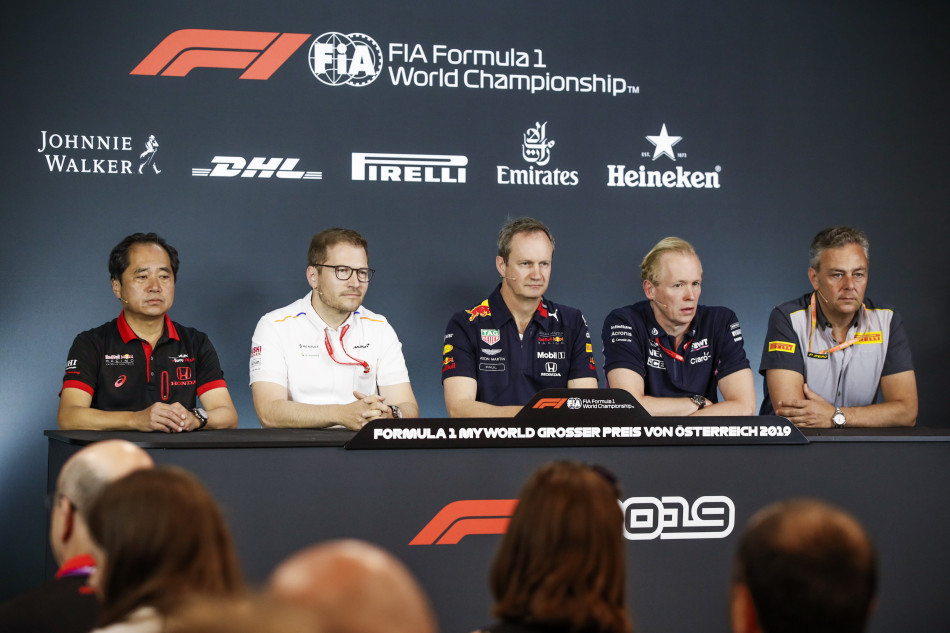
Q: Mario, if we could start with you please, you had a meeting this morning with the 10 team principals. Please can you explain what that meeting was about and what conclusions were drawn?
Mario ISOLA: It was mainly to understand if there is anything we can do to improve the show. We know the dominance for Mercedes is not helping the show at the moment and we had a discussion of the opportunity to reintroduce the 2018 tyres but after analysing the positive side and the negative side the conclusion was that we want to stay on the current… well, there was a vote from the teams and the decision is to stay on the current tyres. The meeting was quite productive; there were new ideas, new proposals for maybe the end of the season. Obviously we have to analyse that. At the moment they are just ideas. Let’s see. We will continue the discussion in the next days and maybe we come with a proposal for Silverstone or something like that. I don’t know yet because it was discussed two hours ago.
Q: Thank you. Can you also tell us what the plan is for next week’s tyre test here at the Red Bull Ring?
MI: We continue our development for 2020. As I already said, the main target is to have a wider working window for next year’s compounds. So, both in Austria and after Silverstone we will test new compounds, new philosophy, new types of compounds in order to achieve this target, in order to finalise the new construction for next year – because the current cars are really faster and faster, so that means they are putting more energy into the tyres and we have to cope with this energy and all the modification of the construction is to make them work better, and the compounds to have a wider working range and no issues with the aero map, and no blisters and overheating. Obviously the target is always to reduce overheating because it’s something the tyres don’t like, so I would say the two main targets are keeping that… safety is a target that is always there, we cannot consider a tyre that is not safe for Formula One. The targets are to have a wider working range and less overheating for next year.
Q: Andreas, if we could come onto you. Welcome, your first FIA press conference. You’ve been team principal of McLaren for a couple of months. Can you just tell us how it’s going and what you found when you arrived at the MTC?
Andreas SEIDL: Well, what did I find? Still early days, to be honest. It’s a big organisation. I got a very warm welcome from the team from the beginning. It also helped to get started that, compared to last year, the team has made a huge step forwards with the car. So all the changes that have been initiated last year already are paying off. I’m still in the period of really analysing in detail what’s going on inside the team, to find the strong and the weak points inside the team in order to then work out a clear plan how I want to, let’s say, approach the future with the team. Obviously Zak and the shareholders gave me the clear task to work out, as quickly as possible any deficits I see, also on the infrastructure side. So, I was very happy to announce last week that we got this positive decision on the wind tunnel, which was a quite obvious deficit compared to the top teams. So, very happy, it’s good to see that we are making steps, race by race now at the moment. It’s important for me to keep this positive journey going.
Q: As you say, McLaren is a team on the up at the minute. What is the mood in the camp?
AS: It’s obviously very, very positive. As I said before, results help; it’s good to see that the car is reacting to developments, different to last year. We are still bringing bits also for the next races, so we better and better understand the car. Also, we have a great working environment also together with the drivers. They perform very well on track. They have a great interation in terms of car development, also with the team at the track and the guys at home. All pretty positive. At the same time, the battle in the midfield is very, very tight – so it’s also no reason to get over-excited. It’s just important now to keep our heads down and keep pushing day and night.
Q: You have a great result in France last weekend, sixth and ninth – but how concerned are you about a repeat of the hydraulics issue on one of your cars this weekend?
AS: We obviously disassembled the car afterwards and found an issue on a single part. We think we have identified the root cause of the issue and hopefully it was a one-off.
Q: Paul, can we start by talking about this year’s RB15. What were your expectations coming into the 2019 season and has the car met them?
Paul MONAGHAN: I suppose form a team point of view, no we’re not walking off into the distance and winning every race, so there’s an element of frustration rather than disappointment. Don’t forget, we were the ones that changed power unit and then picked up the bodywork changes, so we probably took more on in the winter than some of the others. These cars don’t stand still. They’re prototypes, aren’t they? So every race it’s changing, sometimes by larger amounts, other times by smaller amounts. Our friends at Honda are upgrading as and when they can. So, as a package we’re trying to move forward. The target is clear and yeah, it’s improving all the time and the rate of improvement relative to our opposition that will see whether we can catch them?
Q: Well, how do you rate your chances of catching the two teams ahead of you? Do you think it’s possible within the current season to do that?
PM: Yes, I think you have to, otherwise you sort-of say ‘we’re going to look at next year’s’. We’ll try and learn and move on at every stage we can and if the closer we get to them, the better off we are for next year, if we catch them, great. It’s really a case of making our own progress. The only thing that’s within our control is the performance of our car. We can’t influence the others, they’ll do what they’re going to do and it’s heads down and get on with it really, isn’t it?
Q: And can we talk about drivers. We’ve seen tremendous consistency from Max Verstappen this year – but it’s been a bit up and down for Pierre Gasly, although he appeared to have a good morning this morning. What have been Pierre’s issues with the car?
PM: Pierre finds it a little bit more difficult to drive in certain sections of the corners – I think – than Max from his comments but he’s a quick, young driver. Let’s not forget that. And he’s up against a very strong team-mate. He’s much happier this weekend, straight away. He’s on the pace, so his confidence is on the up again. He’s part of our team. We’ll support him as best we can with every bit of energy we’ve got and I think he’ll come good.
Q: Tanabe-san, Paul says that you’re bringing upgrades as fast as you can and three of your cars run the new spec-3 power unit in France. All four cars are running it here. Did it perform at Paul Ricard as you expected?
Toyoharu TANABE: Basically yes. We could see some improvement in the data when we ran the lastest spec at the track. And then, we compared to the dyno data and we see improvement trackside as well. But, on the other hand, the improvement is not significant, so as I mentioned before, when we introduced spec-3, there was a reliability and then a performance improvement – but the performance is not huge, which means we still keep pushing to perform well.
Q: You talk about pushing to perform well. It’s quite early in the season to have introduced your third upgrade. Will there be another new spec this season and, if that’s the case, can you tell us when that might be?
TT: Yes, so as you are thinking, just before halfway in the season, we already apply third PU and we are planning to introduce another spec sometime this season – but I don’t tell you exactly when and how much improvement we will have. We will announce later.
Q: You’ve said development of this spec-3 involved working closely with Honda’s jet division. Can you just tell us how that worked?
TT: So, we have a Honda R&D, so the one division is Honda Sakura R&D which takes care of the Formula One racing project. Then we have a big technical centre including many types of technology. The we use that resource and collaborate very closely. Not only jet engines but also other parts. As a result, we introduce at the last race the new turbocharger using… from the collaboration between Honda Racing technology and jet engine technology. So, we tried to make performance better, not only from the small Racing group but also the all the resources of Honda R&D.
Q: Andy, very tight midfield this year. Checo was 12th for the third consecutive race last weekend. Can you tell us about the performance of your car, the RP19, its idiosyncrasies and where do you see your main opportunities in the next couple of months.
Andrew GREEN: Yeah, you’re absolutely right, the midfield is incredibly tight. It only takes very small margins to move you from one end of the field to the other. The car has got some balance issues that we started the season with and really I think that’s a bit of a legacy of where we finished off last year and where we were as a company, position-wise. We’ve got a lot of changes coming ahead in the next few races and beyond, after the break as well. So, I think we’re making progress and, as Paul alluded to, it’s all a relative game really: we’ve got to make more progress than our competition – which is hard to do. It’s very hard to do. We’ve got a lot of work to do but the atmosphere in the team is incredibly buoyant. The team’s future is incredibly bright. We’re looking a long way forward with the team now, that we’ve never been able to do before, and so the fact that we’re in a bit of a tight scrap at the moment is not distracting now from things that we’re looking at much further down the road – so it is an exciting time for the team, it really is, like I’ve never seen before. So, we’re really looking forward to not just fighting this season but, from what we can do and what we can achieve going forward as well into the season beyond. It’s an exciting time.
Q: And what about Lance Stroll? He’s raced well this year – three points finishes – but he’s been struggling in qualifying. What have been his issues and how can his engineers help him find a solution?
AG: Yeah, there’s no denying his Saturday afternoon performance, he’d say the same, he struggles on a Saturday afternoon but we have to put it in perspective. He’s in a very early part of his career and he’s up against a very mature, experienced driver on the other side of the garage and he’s learning a lot. In each race and in each session we give him targets and what to look for and how to improve and it’s small margins every time – but he understands it. He’s an incredibly talented driver. We’ve seen that numerous times – and it’s a case of just getting the experience. And once he gets the experience and gets the confidence, we’ll see him close the gap to Checo and potentially take a leap ahead of him. So, we’ve got every confidence he can do it – it just takes a bit of time.
QUESTIONS FROM THE FLOOR
Q: (Scott Mitchell – Autosport) To the three team representatives please. We started the press conference talking about changing the tyres mid-season. Can you just give us your thoughts on the decision not to change tyres and the prospect of a change later in the season? Obviously there wasn’t a change now, so why would it change later on?
AG: Really, we listened to the arguments and we especially listened to this man on my left; Pirelli are the experts in this area. And from what we could tell, it wasn’t clear cut at all that a change, reverting to last year’s compound gauge thickness was going to be a positive change. It sounded like a significant risk to us. From our perspective it’s too late for this season and I think the decision to focus on trying to do something and trying to improve the tyres and the show for next season is the right thing to do. And I think to try and not distract from the testing that’s going on post this event and post-Silverstone as well is the right decision and focus on next year, and try to do something for next year, rather than a kneejerk reaction in the middle of this year.
Thank you. Paul, your thoughts?
PM: It’s difficult isn’t it. It puts Pirelli in a slightly difficult position. They’re doing a decent job, they’re going to win every race, the tyres are surviving on the cars, and as Mario points out, they’ve got to maintain their safety record. At the risk of being slightly controversial with regard to Andy’s comments, we would quite happily accept the 2018 tyres to come back. I don’t think the risk is as great as some perceive. But it is about creating a show and I think we almost have to take a step back and take a slightly less team-centric position and turn around and say ‘well, if it would be better for the show, could the teams cope with it’ and our opinion is yes, we could. We accept there has been a majority vote not to do so but we hold a slightly different view to the majority then.
And Andreas?
AS: Well, I think first of all it’s important in all fairness to Pirelli to mention that we don’t have a tyre issue in general here. I think Pirelli, the product we have this year is matching all the requirements we set out last year, as Formula One, for what we want to have. I think in the end the reason why we have this discussion at the moment is that we have three top teams with the same resources and one team is doing a significantly better job than the other two. So that’s that situation we are facing. There is nothing we can really influence as McLaren. I think it’s down to the three top teams, with the FIA and Formula One to see if there is anything that can be done short-term to fix that issue. I think in general we have a far bigger issues which is this big gap we have between the top teams and the midfield. That is also where our focus is on. This is something also that cannot be solved in the short term, so we have big hopes for all the changes that are on the table on the financial side, technical side, sporting side, regarding the regulations in ’21 and hopefully F1 and the FIA with all the experts which they now have onboard, which is a unique situation, pull through. We full support the changes that have been sent out some weeks ago and that is our focus to be honest.
Q: (Dieter Rencken – Racing Lines / Racefans.net) Mario, the vote, 5-5, do you take that as a vote of confidence in your product or a vote of no-confidence in your product? And if your product was in line with the target letter then should the target letter just be scrapped?
MI: No, I don’t think so. The target letter is fixing some parameters in terms of delta lap time and degradation and characteristics of the tyre. That means we can change the target letter for the future and we can put numbers that are better for the show. As Andreas said, we made a product in line with the requests coming from F1. Don’t forget what happened last year: the drivers were complaining about overheating, and if we go back to 2018 tyres we go back to overheating, to blistering, and all the different stuff, where basically we were working on to make a better tyre for this year. So what is clear to us for next year is to develop a wider working range in order to have more teams that are able to use the tyres better. I am very confident that for the second half of the season most of the teams will learn how to use the current tyres, because it’s always a learning curve. Every year it was the same. Going back to last year’s tyres on the technical side was not the right decision and I’m happy that five teams recognised that and voted against the change. On top of that we are very happy to work together with the teams, the driver and FIA and FOM to find a better solution for the sport as we did in the past and as we have always done. Provided that safety and the image of the company are protected we are here to do something good for Formula 1. If this is not the right direction then let’s change the direction, but we need to agree what is the direction, because at the end of the day we make one tyre for everybody, not get customised tyre for any car.
Q: (Ian Parkes – New York Times) A question for Andreas. Andreas, you talked about the positivity within McLaren, but you’ve come into the sport at what appears to be quite a negative time, primarily due to the dominance of one team, as you mentioned, Mercedes. Can I just get your thoughts as to what your perceptions were of F1 before you joined McLaren, what your perceptions are now that you have been with the team for a couple of months, and what you would like to see going forward, primarily from 2021 onwards?
AS: Well, I’ve been following Formula One the last 10 years as a fan and I think it hasn’t lost anything. It is still the platform, which works. It does not change compared to 2009 when I left Formula One. Of course there is an issue, as I mentioned before, with this big gap between the top teams and the midfield teams. Simply the resources these teams are having, let’s say, went out of control compared to what we, for example, can do. It’s not possible for us to be competitive and sustainable at the same time. Again, this should not hide that we have, in general, some work to do inside the team, independent of, let’s say, the boundary conditions we are in at the moment. So I think it’s very, very important to get this right for 2021. I think the objectives are clear for everyone involved and there is also huge agreement regarding the objectives. First of all I think the biggest, or most important topic, is to introduce the budget cap, because that is the only guarantee really to have somehow a level playing field between the teams. We would prefer that is even lower than the numbers that are under discussion at the moment. But we also understand that it needs to be a compromise in the end. Then I think it’s simply important to get the technical and sporting regulations right. It’s important to be a bit more restrictive in terms of the freedom on the development side, which then allows to have the field closer together. At the same time we are up for still having some freedom as the better team should still be able to make a difference. I think everything is on the table and it’s just important now that Formula One and the FAI is pulling through and the whole regulations that are in discussion at the moment don’t get softened again by, let’s say, the agendas of the teams, their own agendas.
Q: (Julien Billotte – Auto Hebdo) A question to Tanabe-san and Paul. Max Verstappen said yesterday in this press conference that he is keen to evaluate the updates that are coming on your package over the next few races. How confident are you that you can give him the equipment he needs to continue to trust the Red Bull-Honda project and stay with the team longer term?
PM: To answer your question directly: we are confident that we can give Max a car that enables him to challenger for race wins and beyond. The time scale is not within our control, because you have to catch the others and pass them to achieve this. There are a number of update on both, as Tanabe-san said, with the engine and on the chassis side to improve our performance. We will deploy those as and when they are ready and we know that, or believe that they are right and will make a reasonable difference to the car and if we can make some progress towards that it’s really all on the cars for the start of next season and who rolls out the door fastest then.
TT: Yes, so we both work very hard to achieve our objectives or our target. I understand the feeling from the cockpit, so we try to deliver performance, not only PU but also chassis. So as Paul said we keep working very hard to keep our driver, so Max, in the confident car. That’s our goal anyway. So we are working very hard. We understand there is a space or a gap to achieve that top level also the period to improve our performance.
Q: (Péter Vámosi – Racinglines.hu) Andreas, Bernie Ecclestone confirmed yesterday that four years ago he was in talks with Volkswagen Group and Porsche and Audi that they can come to Formula 1. Can you confirm this and could you imagine that in 2021 we can again have a marriage between McLaren and Porsche?
AS: Well, obviously I have a new shirt on, so I can’t comment on what happened at my previous employment. I think in general it’s very difficult for a new engine manufacturer to come in. This is why I think also that from ’21 onwards it makes sense at the moment to really keep the regulations as they are, because we see at the moment already that with keeping the regulations stable all the power trains are coming closer together. And then, I think as far I can see at the moment, we simply have to wait for the next cycle of the regulations and we have to see then also how the automotive industry is going, in which direction, to see if then there is any chance to create any interest for another manufacturer to come into this sport.
Q: (Maria Reyer – Motorsport-Total.com) Mario, Toto Wolff said after the meeting today that we could see at the end of this season already 2020 tyres being used, maybe in practice, to be tested. Do you see this is possible from a protection side and do you think this maybe could be the case at the end of the season?
MI: Yes, it is possible because the current regulations allow us to do that. So we can supply two additional sets of prototype tyres for evaluation during Friday. And there was also the discussion to slightly change the regulations to understand if different tyres can be used during the race weekend, not just in free practice. This is, as I said, a completely new idea and it has to be evaluated and discussed and the FIA should come with a wording to propose but we are open to evaluate that and we will continue our development test for the next weeks, but if we also have the opportunity it is a good opportunity to test the product for next year during the season.
Q: (Sam Collins – RaceCar Engineering) To Andreas and Paul: just following on from one question back, Andreas you’ve worked with a number of technical working groups in different championships and you mentioned that you wanted to see the new engine regulations in future that will attract new manufacturers to the series. What rule changes would it require, what would the new power unit need to be to attract a new manufacturer to the series in your opinion? And Paul, as a team that has relationships with two automotive manufacturers, from Red Bull’s point of view as a team, what do you think is needed from the engine regulations in ’25 to bring new manufacturers into the sport?
AS: First of all, obviously there are a lot of changes ongoing at the moment in the automotive industry with the powertrains, electrification and so on, so I think for the next cycle of regulations you simply have to make the next step of hybridisation, definitely. This is the technical aspect but in order to be attractive as a sport for a manufacturer to enter again, I think it’s also very very important to make sure you can enter this sport with an investment which is a lot smaller compared to what you have to do now with budgets that are a lot smaller, because again, if you want to enter this category at the moment, then the investment you have to do for the infrastructure and the budget you have to use in order to get to the point where the established manufactures are, you have to be realistic. Pretty difficult to imagine that anyone would invest that money at the moment.
PM: It’s an interesting question for 2025. I suppose I will answer it by saying that – if you asked me what would I presently do, I would try not to upset the four that are there at the moment, to find ourselves down to two, one of them being new, just as an example. So if you take that point of view, the four that are currently investing and developing engines are supplying them to all ten teams, you could argue on a complete clean sheet of paper but then it rather negates all the work that they’ve currently done. And taking Andreas’s point that you don’t want the new rules to be intimidating to anybody else wanting to come in, you clearly have to strike a compromise somewhere and where that lies I wouldn’t want to comment at the moment. That’s my thought for 2025.
Q: (Daniel Majet – GPHirek.hu) When there is talk about the spectacle of Formula One, it is often compared to IndyCar. Do you see in it from a technical aspect, chassis, engine, whatever, that can be considered, which is now in IndyCar, for the future of Formula One?
MI: I believe that we should look at any other series that’s providing the show, not just IndyCar. If we look at the other series with an open mind, we can find solutions also for Formula One, keeping in mind the DNA of Formula One because it is clear that we cannot have a Formula One that is a standard series like Formula Two or something like that. There are a lot of dedicated aspects to consider but observing the rest of motorsport with a critical view can only be positive.
AG: I think the regulations moving forward in 2021 do take some of other formulas technology, I think with moving towards more of a ground effect car going forward. I think that definitely comes from the north American series, which, if we’re looking at, trying to have the cars race closer together then I think that’s the right thing to do, that makes complete sense. But I think the same, I think we need to keep Formula One at the pinnacle, it needs to be a technological amazement really. That’s where I think the sport needs to be, it’s not just about having cars that are close, it’s about a bit more of a Wow factor and we need to make sure we don’t lose any of that.
PM: To answer your question directly, yes, I think you can learn from other series. Your specific question of IndyCars Andy has partly answered I think in that the way they generate their downforce is of interest to us. The question becomes can they run closer, can we still maintain differentiation between the cars as opposed to stock bodywork as they would call it over there? So I think you keep an open mind and you look and you learn and you don’t assume that you have perfect knowledge. I think that open-mindedness will serve us well.
AS: Yeah, same from my side. I think we all do - Formula One, FIA and the teams should also currently look at what’s going on in other categories, on the technical side and also on the sporting side which has a big impact as well, the sporting regulations of how the show is actually happening on track. I think some aspects of the ’21 regulations like standardisation and so on, limitation of the freedom regarding the aero development and so on, they’re going in the direction we see already in other categories. There’s a lot of work going in to also to allow this closer racing so I think we are not far off with the proposals that are on the table. As I said before, we just need to pull through now.
TT: Yes, IndyCar and Formula One are sports and also entertainment. I think there is a big differences between the two series and also the spectator characteristics are different. But it’s good to learn from each other or share the idea which enforces the Formula One, which enforces IndyCar and then supplies much more until the spectator is good, I think.
Q: (Carlo Platella – F1ingenerale.com) A double question for Mr Seidl: McLaren introduced a new front suspension in France. Is the introduction of such an important component in the middle of the season a result of the new organisation of the team? And have you noticed a significant improvement in performance thanks to it?
AS: Well, I think with the limited testing which is available in Formula One nowadays, which we all support also, you simply have to use the Fridays also to try let’s say adventurous stuff, which we did in Paul Ricard. It’s nothing we follow up at the moment. It was – let’s say – an engineering exercise, a learning exercise for the engineers and we have to see now what we do now with the conclusions of that test, regarding future developments we want to bring to the car this year or next year.
Q: (Ian Parkes – New York Times) Andreas, can I just get your thoughts on the season Lando is having so far, his plus points, what he’s done? Well, he’s obviously had a bit of bad luck but his plus points, what he’s done well, where you feel he needs to improve? He needs to learn in his first year, at the end of the day, and also get your thoughts on his obsession with his home simulator and how much that is helping improving him as a driver?
AS: Well, first of all, I was obviously very very impressed, straight from the beginning, even during the first races when I was still watching the races from home, with what Lando was doing on track. If you come into Formula One and you go into your first qualifying in Melbourne with a car that was maybe somewhere between – in terms of performance – ten to 14 and you score P8, it’s an impressive achievement and it was not just a one-off, he did that now several times which is great to see, also how he handles the races, I think it’s great. He had some bad luck in terms of results but I think that’s nothing which is too worrying at the moment, so we are very very happy inside the team, also how he interacts with the engineers regarding the development of the car, with the guys here at the track and also back home so very encouraging to see and I think he will have a great future in Formula One and obviously with the McLaren team as well, long term.
Q: And his home simulator?
AS: Yeah, I think that even here in the motorhome there’s a big competition going on between Carlos and him each day, battling each other on the simulator so he’s obsessed with that, he’s convinced and we can see that also that it helps him to prepare the races, to be sharp when he’s arriving here, in addition to the simulator work he’s also doing with the guys back home in Woking. It’s great to see, this new generation also how they prepare themselves for this challenge in Formula One, and again, very excited to work together with him and the same for Carlos, I think we have a great driver line-up and they will be the future for this team.
Q: (Dieter Rencken – Racing Lines / Racefans.net) To Mario and the three team representatives: if one has a single tyre supplier, surely it’s inevitable that some teams are going to be marginalised by this. If we are looking at tyres to improve the show, should we not be looking at multiple tyre suppliers in Formula One in future when the current contract expires?
MI: You know everybody is talking about the budget cap and multiple tyre supplier means a lot of cost more. Don’t forget when we had the multiple tyre supplier, the top teams had a specific test team just for tyres and introduction of new tyres, new prototypes every race so it’s a bit against the philosophy of having a cap on the budget. But if this is the decision of the sport, we will evaluate that as we told you in the past and obviously with a different approach, it’s a lot more about the performance and other stuff rather than the same product to everybody and with the characteristics which are decided by the famous target letter. Or we can try to find different values in that document to enhance the show. Maybe it is possible. We are working with the FIA and FOM in order to have different numbers for the future.
AG: Yeah, I think multiple tyre suppliers goes against the whole ethos of trying to compress the grid and improve the show. You are going to end up with the haves and have-nots with respect to tyres. Currently we all have the same tyre and we can all do the same job, up and down the grid. I think the team that does the best job with the tyres should be rewarded for that so I don’t think that’s the right way to go for the show, to be honest.
PM: In the current generation of Formula One then multiple tyre suppliers don’t really fit with the model. We don’t go tyre testing every week and tyres per se are not a prime performance differentiator so at the moment our current working philosophy, if you like, is to have a single supplier. It would change everything that is on the table now and I believe plans for the future if we were to bring in multiple suppliers and I don’t if you would close the field up or spread it out in that circumstance. At the moment, we’re not really equipped to go down that route.
AS: Well, I think we should also not forget that even in the years of the biggest tyre war, sometimes we had a total dominance of one team throughout the entire season so I’m not convinced that this is the solution. I think it’s simply important now that between the teams, together with the FIA and FOM that we have, let’s say that we take our time to really define clearly what is the target letter for the tyres for next year and for ’21 and I think that’s the way to go, to be honest.
Ends

 Facebook
Facebook Twitter
Twitter